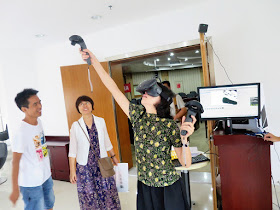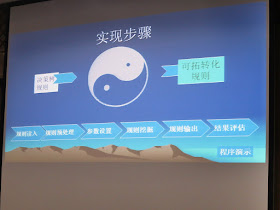The seminar
for Innovation Product Development – Extenics application in Shenzhen (產品研發創造力研討會 -可拓學在深圳創新的運用) was organized by Shenzhen
Intellectual Property Council (深圳市知識產權局) and organized by Shenzhen Intellectual Property Society(深圳知識產權研究會) on 28 Jun 2016. This seminar was focused on application of
Extenics in different industries and exchanged ideas from different
experts. Mr. Yin Hanfan (鄞漢藩) (General Secretary, SZIPS) was
MC and introduced all speakers in the beginning of the seminar.
Before
the seminar, Mr. Chen (陳民鋼處長 -深圳市知識產權局)
gave the welcome speech. He told us
there had 100 thousand IP was grant in last year in Shenzhen. Shenzhen government would focus on the
application to enhance companies’ competitive edge
Prof. Yang
Chunyan (楊春燕)
(Director, Institute of Extenics and Innovation Methods, Guangdong University
of Technology) was the first speaker and her topic entitled “Thinking
Innovation based on Extenics – Establishment and Application of Base-element” (可拓學的思維創新 – 基元的建立與應用).
Prof.
Yang introduced the four steps of Extenics and they were Model, Extension, Transformation
and Selection.
Basic-element
(基元) theory
utilized Matter-element (物元), Affair-element (事元) and Relationships-element (關係元) were discussed as the foundation knowledge
of Extenics.
Mr.
Simon Su (蘇振慶) was the
second speaker and his presentation title was “Four basic extensible directions”
(四種基本拓展的方向). They were Divergence (發散樹), Correlative (相關網), Implication (蘊含系) and Opening-up (分合鏈).
Mr. Su
used six pulse sword (六脈神劍) to explain six types of extension. The first type was Tree of Divergent
(發散樹 – 東風夜放花千樹) and they included One Object
Many Character s (一對象多特徵), One Character Many Objects (一特徵多對象), One Character Many Values (一特徵多量值), One Value Many Characters (一量值多特徵), One Value Many Objects (一量值多對象) and Same Object & Value but
Many Characters (同徵同值多對象). The others extensible directions
included Correlative (相關網 – 風馬牛也相及), Implication (蘊含系 – 如果那麼, 因為所以) and Opening-up (分合鏈 – 化整為零, 按需組合). His approach was to explain the idea and
then focus on application. After that he discussed the case in each type of
extension.
The
third speaker was Mr. Wong (黃盼) and his topic named “Extenics Innovation and Skill”. Firstly, he briefed the fundamental theory of
Extenics including Basic-elements, Extension, Transformation and Selection, as
well as, five types of transformation.
Then he
shared the application on mobile unlock functions. The following case used Affair-element for
input and output screen of mobile.
Another
extensible case was introduced. The idea
was to separate the time into Morning, Afternoon and Night and considered
customer’s behavior for screen design.
The fourth
speaker was Mr. Chen (陳亮) and his topic named “可拓變換在技術創新的應用”.
Firstly, he mentioned different transformation methods included Replacement
(置換), Increase
or Decrease (增減), Delete (删減), Expand (擴大), Reduce (縮小), Break Down (分解) and Copy (複制).
Then Mr.
Chen focused on Bionics (仿生學) which is the application of biological methods and systems found in
nature to the study and design of engineering systems and modern technology.
Finally,
Mr. Chen employed Drones (無人機) as example to explained using Extenics such as物元@無人機, 事元@無人機and關係元@無人機.
The
fifth speaker was Mr. Li Wen Guang (李文廣) and his presentation entitled “Four steps
- Model, Extension, Transformation and Selection, as well as Digital Technology”
(建、拓、變、選 - 四步法與數字技術).
Firstly,
he introduced the app in mobile which was developed by his team for Extenics to
employ Model, Extension, Transformation and Selection steps.
Then he
employed Extenics theory on VR mobile design.
The sixth speaker was Mr. Li Wen Guang (李恒輝) (Shenzhen Micro I Technology Ltd.) and his topic was “Conjugate Analysis to Solve the Conflict Problem” (解決矛盾問題的共軛分析方法).
He used the novel named “天龍八部” to explain 4 pairs of conjugation. The four conjugation pairs were “Real vs Virtual”, “Hardware vs Software”, “Plus (+) vs Minus (-)” and “Obvious vs Hiding”. Then he used a listed company as case study and explained how the founder used
Dr. Aaron Tong (唐偉國) (HKIE & HKSQ) was the seventh speaker and his topic named “Modern Innovation Theory and Extenics Methodology” (當代創新理論及可拓創造法). Firstly, he discussed what innovation is and showed different examples. One is Six Sigma’s DMAIC approach.
Then he used a case (Africa people without shoes) as a example to employ Extenics theory including Basic-element and Conjugate Transformations. He raised three innovation methods named “Create from Zero” (無中生有), “Copy from Different” (見異思遷) and “Addition through Conjugation” (錦上添花).
Finally, Dr. Tong asked a question to all participants if you had a pressure gauge, how did you know the building height. Many people answered to use physics and engineer point of views. But Aaron asked to think out of your professional. He gave one possible answer that giving the pressure gage as gift to the building security officer and asked him how height the building is.
Prof.
Xingsen Li (李興林) (VP of Management School, Ningbo Institute of Technology, Zhejiang
University) was the last speaker and his presentation title named “” (互聯網背景下的客戶流失預警與可拓轉化). Customer is the asset of enterprise. According to Gartner company survey, it
expensed to find a new customer was five times cost more than keeping an old
customer.
Prof. Li
said new registered customer in the internet and lost online customer were always
happen with large quantity. However, it
implied Risk and Opportunity. Therefore,
he proposed to use Extenics in Data Mining.
Then the implementation steps from “rule input” to “pre-treatment of rules” to “parameters setting” to “rule mining” to “rule output” and finally getting the “evaluation results”.
Lastly,
Prof. Li suggested a Management Collaboration Innovation Model included both
in-house experts and all staff in the enterprise.
After
the seminar, I got Prof. Li’s signature in his new book and took a photo for
memory.
Then
HKSQ representatives Dr. Aaron Tong and I took a photo with Prof. Li.
Reference:
Shenzhen
Intellectual Property Council (深圳市知識產權局) under Market and Quality Supervision Commission of Shenzhen
Municipality (深圳市市場和質量監督管理委員會) - http://www.szmqs.gov.cn/
廣東工業大學可拓學與創新方法研究所 - http://web.gdut.edu.cn/~extenics/hyanjiusuo.htm
20160229:
HKCIE Seminar on Extenics (可拓學) - http://qualityalchemist.blogspot.hk/2016/02/hkcie-seminar-on-extenics.html
Research Institute of Extenics and Innovation
Methods, GDUT (廣東工業大學可拓學與創新方法研究所) - http://web.gdut.edu.cn/~extenics/hyanjiusuo.htm
Previous Extenics
activities:
20160605: The 2nd
meeting of the Innovation Alliance of the Extenics (可拓學) - http://qualityalchemist.blogspot.hk/2016/06/the-2nd-meeting-of-innovation-alliance.html
20160522: The meeting with Prof. Cai Wen for
promoting the Extenics (可拓學)
to Hong Kong - http://qualityalchemist.blogspot.hk/2016/05/the-meeting-with-prof-cai-wen-for.html
20160507: The meeting for establishing the
Innovation Alliance of the Extenics and its application and promotion - http://qualityalchemist.blogspot.hk/2016/05/the-meeting-for-establishing-innovation.html
20160506: Visit to the Institute of Extenics
and Innovation Methods and HKQAA Guangzhou office - http://qualityalchemist.blogspot.hk/2016/05/visit-to-institute-of-extenics-and.html
20160416: Patent Analysis and Corporate
Development Series 2016 - Extenics (可拓學) - http://qualityalchemist.blogspot.hk/2016/04/patent-analysis-and-corporate.html
20160229: HKCIE Seminar on Extenics (可拓學) - http://qualityalchemist.blogspot.hk/2016/02/hkcie-seminar-on-extenics.html


























沒有留言:
發佈留言